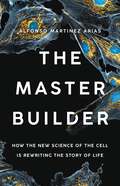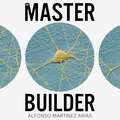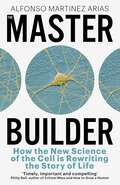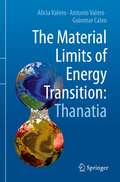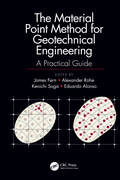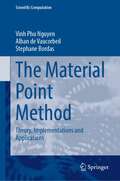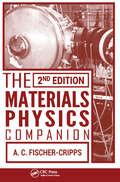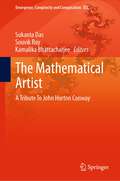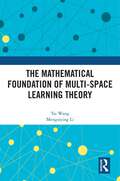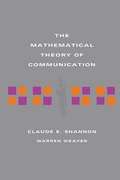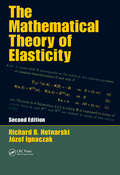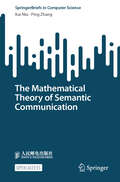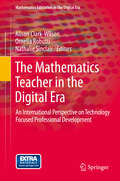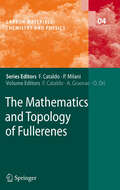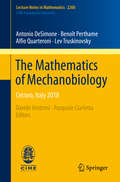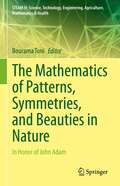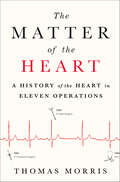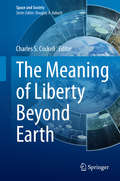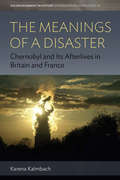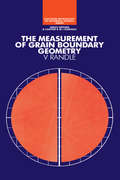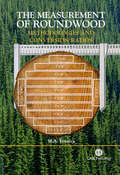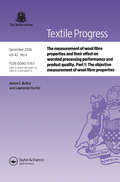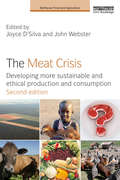- Table View
- List View
The Master Builder: How the New Science of the Cell Is Rewriting the Story of Life
by Dr. Alfonso Martinez Arias"An ingenious argument" (Kirkus) for a "novel thesis" (Publishers Weekly) that cells, not DNA, hold the key to understanding life&’s past and present What defines who we are? For decades, the answer has seemed obvious: our genes, the &“blueprint of life.&” In The Master Builder, biologist Alfonso Martinez Arias argues we&’ve been missing the bigger picture. It&’s not our genes that define who we are, but our cells. While genes are important, nothing in our DNA explains why the heart is on the left side of the body, how many fingers we have, or even how our cells manage to reproduce. Drawing on new research from his own lab and others, Martinez Arias reveals that we are composed of a thrillingly intricate, constantly moving symphony of cells. Both their long lineage—stretching back to the very first cell—and their intricate interactions within our bodies today make us who we are. Engaging and ambitious, The Master Builder will transform your understanding of our past, present, and future—as individuals and as a species.
The Master Builder: How the New Science of the Cell is Rewriting the Story of Life
by Alfonso Martinez AriasA leading developmental biologist argues that cells, not DNA, hold the key to understanding history, present, and future of life.What defines who we are? For decades, the biological answer has been our genes. In The Master Builder, leading biologist Alfonso Martinez Arias breaks with decades of scientific and popular tradition to make a bold argument: what defines us is our cells. Drawing on new research from his lab and others, Martinez Arias reveals that we are composed of a thrillingly complex, constantly rearranging symphony of cells that know how to count, feel, and ultimately give form to our bodies. While DNA is important, Richard Dawkins's vision of the selfish gene that controls everything is not a good description of how biology actually works. As Martinez Arias shows, nothing in your genes explains why your heart is on the left side of your body, why you have five fingers and not ten, or why genetically identical twins have different sets of fingerprints and why it's possible for a mother to apparently share no DNA with the children to whom she gave birth! At the heart of it all is not simply gee-whiz science, but a powerful new conception of the essence of life.Our identities are shaped not simply by our genes, but by the interconnections between all our cells, working as a sort of symphony-cooperative, and creating something greater than its parts could on their own-and the unbroken lineage of cells that connects us to the first fertilized egg from which we developed-and in turn, back through the billions of years of our planet's history, to the very first cell in the history of all life on Earth.A sweeping revision of both the present and history of life, The Master Builder puts forward a new paradigm for understanding biology, one rooted in cellular cooperation, not selfish genes. Engaging and ambitious, it will transform our understanding of where we come from, what shapes us, and where we are going, as individuals, a species, and the community of life itself.(P)2023 Hodder & Stoughton Limited
The Master Builder: How the New Science of the Cell is Rewriting the Story of Life
by Alfonso Martinez AriasWhat defines who we are? Until now, the biological answer has been our genes. Leading biologist Alfonso Martinez Arias breaks with popular tradition to make a bold argument: what defines us is our cells. Drawing on groundbreaking research, he reveals that we are composed of a thrillingly complex, constantly rearranging symphony of cells that know how to count, feel, and give form to our bodies. While DNA is important, nothing in your genes explains why your heart is on the left, why you have five fingers and not ten, why genetically identical twins have different sets of fingerprints, or why it's possible for a mother to apparently share no DNA with the children she gave birth to! At the heart of it all is a powerful new conception of the essence of life. Our identities are shaped by the interconnections between cells, working cooperatively, creating something greater than its parts - the unbroken lineage that connects us to the fertilized egg from which we developed and back through the billions of years of our planet's history, to the very first cell of all life on Earth. A sweeping revision of both the present and the history of life, The Master Builder puts forward a new paradigm for understanding biology, transforming our approach to where we come from, what shapes us, and where we are going - as individuals, a species, and the community of life itself.
The Material Limits of Energy Transition: Thanatia
by Antonio Valero Alicia Valero Guiomar CalvoEarth has become a huge mine, with a greater quantity and variety of fundamental mineral resources being extracted year after year. Technology, from electric cars to everyday electrical equipment, consume vast amounts of scarce raw materials. On a planet with limited resources, are these minerals being properly assessed? Will there be enough raw materials to meet the demand of a world population on track to reach 10 billion people? What will be the consequences of accelerated resource depredation? Will the planet one day become 'Thanatia', a resource-exhausted Earth?This book allows readers to understand the mineral heritage of the Earth, considering the demand for raw materials in society, comparing it with the availability of resources on Earth and the impact of mining. The basics of physical geonomics are exlpained, allowing readers to analyse the loss of mineral resources on the planet. The impact of renewable energies and technologies, including electric vehicles, are studied. The book concludes with possible solutions to mineral depletion, from increasing recycling rates, ecodesign measures or alternative sources of mineral resources. Providing numerous tables and illustrations, 'The Material Limits of Energy Transition: Thanatia' gives readers a thorough understanding of mineral depletion. Exploring geology, geochemistry, mining, metallurgy, the environment and thermodynamics, this is a truly holistic book.
The Material Point Method for Geotechnical Engineering: A Practical Guide
by James Fern Alexander Rohe Kenichi Soga Eduardo AlonsoThis practical guide provides the best introduction to large deformation material point method (MPM) simulations for geotechnical engineering. It provides the basic theory, discusses the different numerical features used in large deformation simulations, and presents a number of applications -- providing references, examples and guidance when using MPM for practical applications. <P><P>MPM covers problems in static and dynamic situations within a common framework. It also opens new frontiers in geotechnical modelling and numerical analysis. It represents a powerful tool for exploring large deformation behaviours of soils, structures and fluids, and their interactions, such as internal and external erosion, and post-liquefaction analysis; for instance the post-failure liquid-like behaviours of landslides, penetration problems such as CPT and pile installation, and scouring problems related to underwater pipelines. In the recent years, MPM has developed enough for its practical use in industry, apart from the increasing interest in the academic world.
The Material Point Method: Theory, Implementations and Applications (Scientific Computation)
by Vinh Phu Nguyen Alban de Vaucorbeil Stephane BordasThis book provides an introduction to the fundamental theory, practical implementation, and core and emerging applications of the material point method (MPM) and its variants. The MPM combines the advantages of both finite element analysis (FEM) and meshless/meshfree methods (MMs) by representing the material by a set of particles overlaid on a background mesh that serves as a computational scratchpad.The book shows how MPM allows a robust, accurate, and efficient simulation of a wide variety of material behaviors without requiring overly complex implementations. MPM and its variants have been shown to be successful in simulating a large number of high deformation and complicated engineering problems such as densification of foam, sea ice dynamics, landslides, and energetic device explosions, to name a few, and have recently found applications in the movie industry. It is hoped that this comprehensive exposition on MPM variants and their applications will not only provide an opportunity to re-examine previous contributions, but also to re-organize them in a coherent fashion and in anticipation of new advances.Sample algorithms for the solutions of benchmark problems are provided online so that researchers and graduate students can modify these algorithms and develop their own solution algorithms for specific problems. The goal of this book is to provide students and researchers with a theoretical and practical knowledge of the material point method to analyze engineering problems, and it may help initiate and promote further in-depth studies on the subjects discussed.
The Materials Physics Companion
by Anthony C. Fischer-CrippsUnderstand the Physics of the Solid StateUpdated and expanded with new topics, The Materials Physics Companion, 2nd Edition puts the physics of the solid state within the reach of students by offering an easy-to-navigate pathway from basic knowledge through to advanced concepts. This edition illustrates how electrical and magnetic properties of mat
The Mathematical Artist: A Tribute To John Horton Conway (Emergence, Complexity and Computation #45)
by Sukanta Das Souvik Roy Kamalika BhattacharjeeThis book brings together the impact of Prof. John Horton Conway, the playful and legendary mathematician's wide range of contributions in science which includes research areas—Game of Life in cellular automata, theory of finite groups, knot theory, number theory, combinatorial game theory, and coding theory. It contains transcripts where some eminent scientists have shared their first-hand experience of interacting with Conway, as well as some invited research articles from the experts focusing on Game of Life, cellular automata, and the diverse research directions that started with Conway's Game of Life. The book paints a portrait of Conway's research life and philosophical direction in mathematics and is of interest to whoever wants to explore his contribution to the history and philosophy of mathematics and computer science. It is designed as a small tribute to Prof. Conway whom we lost on April 11, 2020.
The Mathematical Foundation of Multi-Space Learning Theory
by Tai Wang Mengsiying LiThis book explores the measurement of learning effectiveness and the optimization of knowledge retention by modeling the learning process and building the mathematical foundation of multi-space learning theory.Multi-space learning is defined in this book as a micro-process of human learning that can take place in more than one space, with the goal of effective learning and knowledge retention. This book models the learning process as a temporal sequence of concept learning, drawing on established principles and empirical evidence. It also introduces the matroid to strengthen the mathematical foundation of multi-space learning theory and applies the theory to vocabulary and mathematics learning, respectively. The results show that, for vocabulary learning, the method can be used to estimate the effectiveness of a single learning strategy, to detect the mutual interference that might exist between learning strategies, and to predict the optimal combination of strategies. In mathematical learning, it was found that timing is crucial in both first learning and second learning in scheduling optimization to maximize the intersection effective interval.The title will be of interest to researchers and students in a wide range of areas, including educational technology, learning sciences, mathematical applications, and mathematical psychology.
The Mathematical Theory of Communication
by Warren Weaver Claude E ShannonScientific knowledge grows at a phenomenal pace--but few books have had as lasting an impact or played as important a role in our modern world as The Mathematical Theory of Communication, published originally as a paper on communication theory more than fifty years ago. Republished in book form shortly thereafter, it has since gone through four hardcover and sixteen paperback printings. It is a revolutionary work, astounding in its foresight and contemporaneity. The University of Illinois Press is pleased and honored to issue this commemorative reprinting of a classic.
The Mathematical Theory of Elasticity
by Richard B. Hetnarski Jozef IgnaczakThrough its inclusion of specific applications, The Mathematical Theory of Elasticity, Second Edition continues to provide a bridge between the theory and applications of elasticity. It presents classical as well as more recent results, including those obtained by the authors and their colleagues. Revised and improved, this edition incorporates add
The Mathematical Theory of Semantic Communication (SpringerBriefs in Computer Science)
by Ping Zhang Kai NiuThis Open Access Book explores how classical information theory&’s focus on syntactic information has limited the further development of communication science. Recently, communication technologies that handle and transmit semantic information have gained widespread attention in academia. Semantic communication has paved new directions for the future of communication technology development, yet it lacks a general mathematical guiding theory. To address this challenge, this open access book constructs a theoretical framework for semantic information theory and provides a systematic exposition of the measurement system for semantic information and the theoretical limits of semantic communication. It serves as a professional reference for researchers in information and communication. The book begins by deeply analyzing the data characteristics of various information sources and the needs of downstream tasks to summarize and generalize the universal attribute of semantic information—synonymity and to define the synonymous mapping between semantic information and syntactic information. Stemming from this core concept, synonymous mapping, this book introduces the measures of semantic information. It then introduces a new mathematical tool, Synonymous Asymptotic Equipartition (AEP), to explore the mathematical properties of synonymous typical sequences and applies random coding and synonymous typical sequence decoding/encoding to prove the semantic lossless source coding theorem, semantic channel coding theorem, and semantic limited distortion source coding theorem. In addition, the semantic information measures in the continuous case are discussed and a new channel capacity formula of the band-limited Gaussian channel is obtained, which is an important extension of the classical channel capacity. The book is a valuable resource for researchers, academics, and professionals in the field of information and communication, particularly those interested in advancing the frontiers of semantic communication technology.
The Mathematics Teacher in the Digital Era: An International Perspective on Technology Focused Professional Development (Mathematics Education in the Digital Era #2)
by Nathalie Sinclair Alison Clark-Wilson Ornella RobuttiThis volume addresses the key issue of the initial education and lifelong professional learning of teachers of mathematics to enable them to realize the affordances of educational technology for mathematics. With invited contributions from leading scholars in the field, this volume contains a blend of research articles and descriptive texts.In the opening chapter John Mason invites the reader to engage in a number of mathematics tasks that highlight important features of technology-mediated mathematical activity. This is followed by three main sections:An overview of current practices in teachers’ use of digital technologies in the classroom and explorations of the possibilities for developing more effective practices drawing on a range of research perspectives (including grounded theory, enactivism and Valsiner’s zone theory).A set of chapters that share many common constructs (such as instrumental orchestration, instrumental distance and double instrumental genesis) and research settings that have emerged from the French research community, but have also been taken up by other colleagues.Meta-level considerations of research in the domain by contrasting different approaches and proposing connecting or uniting elements
The Mathematics and Topology of Fullerenes
by Franco Cataldo Ottorino Ori Ante GraovacThe Mathematics and Topology of Fullerenes presents a comprehensive overview of scientific and technical innovations in theoretical and experimental studies. Topics included in this multi-author volume are: Clar structures for conjugated nanostructures; counting polynomials of fullerenes; topological indices of fullerenes; the wiener index of nanotubes; toroidal fullerenes and nanostars; C60 Structural relatives: a topological study; local combinatorial characterization of fullerenes; computation of selected topological indices of C60 and C80 Fullerenes via the Gap Program; 4valent- analogues of fullerenes; a detailed atlas of Kekule structures of C60. The Mathematics and Topology of Fullerenes is targeted at advanced graduates and researchers working in carbon materials, chemistry and physics.
The Mathematics of Mechanobiology: Cetraro, Italy 2018 (Lecture Notes in Mathematics #2260)
by Benoît Perthame Alfio Quarteroni Lev Truskinovsky Antonio DeSimoneThis book presents the state of the art in mathematical research on modelling the mechanics of biological systems – a science at the intersection between biology, mechanics and mathematics known as mechanobiology. The book gathers comprehensive surveys of the most significant areas of mechanobiology: cell motility and locomotion by shape control (Antonio DeSimone); models of cell motion and tissue growth (Benoît Perthame); numerical simulation of cardiac electromechanics (Alfio Quarteroni); and power-stroke-driven muscle contraction (Lev Truskinovsky).Each section is self-contained in terms of the biomechanical background, and the content is accessible to all readers with a basic understanding of differential equations and numerical analysis. The book disentangles the phenomenological complexity of the biomechanical problems, while at the same time addressing the mathematical complexity with invaluable clarity. The book is intended for a wide audience, in particular graduate students and applied mathematicians interested in entering this fascinating field.
The Mathematics of Patterns, Symmetries, and Beauties in Nature: In Honor of John Adam (STEAM-H: Science, Technology, Engineering, Agriculture, Mathematics & Health)
by Bourama ToniThis unique book gathers various scientific and mathematical approaches to and descriptions of the natural and physical world stemming from a broad range of mathematical areas – from model systems, differential equations, statistics, and probability – all of which scientifically and mathematically reveal the inherent beauty of natural and physical phenomena. Topics include Archimedean and Non-Archimedean approaches to mathematical modeling; thermography model with application to tungiasis inflammation of the skin; modeling of a tick-Killing Robot; various aspects of the mathematics for Covid-19, from simulation of social distancing scenarios to the evolution dynamics of the coronavirus in some given tropical country to the spatiotemporal modeling of the progression of the pandemic. Given its scope and approach, the book will benefit researchers and students of mathematics, the sciences and engineering, and everyone else with an appreciation for the beauty of nature. The outcome is a mathematical enrichment of nature’s beauty in its various manifestations. This volume honors Dr. John Adam, a Professor at Old Dominion University, USA, for his lifetime achievements in the fields of mathematical modeling and applied mathematics. Dr. Adam has published over 110 papers and authored several books.
The Matter of the Heart: A History of the Heart in Eleven Operations
by Thomas Morris“More than a litany of medical advances—it’s the story of the gritty, bloody and deadly experiences that underlie scientific progress.” —Washington PostAn eye-opening and heroic story of pioneering heart surgeons, structured around eleven operations.For thousands of years the human heart remained the deepest of mysteries; both home to the soul and an organ too complex to touch, let alone operate on.Then, in the late nineteenth century, medics began going where no one had dared go before. The following decades saw the mysteries of the heart exposed, thanks to pioneering surgeons, brave patients and even sacrificial dogs.In eleven landmark operations, Thomas Morris tells us stories of triumph, reckless bravery, swaggering arrogance, jealousy and rivalry, and incredible ingenuity: the trail-blazing ‘blue baby’ procedure that transformed wheezing infants into pink, healthy children; the first human heart transplant, which made headline news around the globe. And yet the heart still feels sacred: just before the operation to fit one of the first artificial hearts, the patient’s wife asked the surgeon if he would still be able to love her.The Matter of the Heart gives us a view over the surgeon’s shoulder, showing us the heart’s inner workings and failings. It describes both a human story and a history of risk-taking that has ultimately saved millions of lives.“A thoroughly engaging history.” —The Wall Street Journal“Morris’s expert guided tour of cardiac surgery and its quirky, brilliant innovators covers a dazzling and dizzying array of procedures and hints at tantalizing prospects for future surprises.” —Publishers Weekly, starred review“A well-developed narrative with no end of heroes.’“ —Kirkus Reviews“Gripping.” —John Crace, The Guardian
The Meaning and Value of Spaceflight
by William Sims BainbridgeThis book presents the most serious and comprehensive study, by far, of American public perceptions about the meaning of space exploration, analyzing vast troves of questionnaire data collected by many researchers and polling firms over a span of six decades and anchored in influential social science theories. It doesn't simply report the percentages who held various opinions, but employs sophisticated statistical techniques to answer profound questions and achieve fresh discoveries. Both the Bush and the Obama administrations have cut back severely on fundamental research in space science and engineering. Understanding better what space exploration means for citizens can contribute to charting a feasible but progressive course. Since the end of the Space Race between the US and the USSR, social scientists have almost completely ignored space exploration as a topic for serious analysis and this book seeks to revive that kind of contribution. The author communicates the insights in a lucid style, not only intelligible but interesting to readers from a variety of backgrounds.
The Meaning of Liberty Beyond Earth
by Charles S. CockellThe purpose of this book is to initiate a new discussion on liberty focusing on the infinite realms of space. The discussion of the nature of liberty and what it means for a human to be free has occupied the minds of thinkers since the Enlightenment. However, without exception, every one of these discussions has focused on the character of liberty on the Earth. The emergence of human space exploration programs in the last 40-50 years raise a fundamental and new question: what will be the future of liberty in space? This book takes the discussion of liberty into the extraterrestrial environment. In this book, new questions will be addressed such as: Can a person be free when the oxygen the individual breathes is the result of a manufacturing process controlled by someone else? Will the interdependence required to survive in the extremities of the extraterrestrial environment destroy individualism? What are the obligations of the individual to the extraterrestrial state? How can we talk of extraterrestrial liberty when everyone is dependent on survival systems?
The Meanings of a Disaster: Chernobyl and Its Afterlives in Britain and France (Environment in History: International Perspectives #20)
by Karena KalmbachThe disaster at the Chernobyl nuclear power plant was an event of obviously transnational significance—not only in the airborne particulates it deposited across the Northern hemisphere, but in the political and social repercussions it set off well beyond the Soviet bloc. Focusing on the cases of Great Britain and France, this innovative study explores the discourses and narratives that arose in the wake of the incident among both state and nonstate actors. It gives a thorough account of the stereotypes, framings, and “othering” strategies that shaped Western European nations’ responses to the disaster, and of their efforts to come to terms with its long-term consequences up to the present day.
The Measurement of Grain Boundary Geometry
by Valerie RandleAs the selection of material for particular engineering properties becomes increasingly important in keeping costs down, methods for evaluating material properties also become more relevant. One such method examines the geometry of grain boundaries, which reveals much about the properties of the material.Studying material properties from their geometrical measurements, The Measurement of Grain Boundary Geometry provides a framework for a specialized application of electron microscopy for metals and alloys and, by extension, for ceramics, minerals, and semiconductors. The book presents an overview of the developments in the theory of grain boundary geometry and its practical applications in material engineering. It also covers the tunneling electron microscope (TEM), experimental aspects of data collection, data processing, and examples from actual investigations. Each step of the analysis process is clearly described, from data collection through processing, analysis, representation, and display to applications. The book also includes a glossary of terms.Exploring both the experimental and analytical aspects of the subject, this practical reference guide is essential for researchers and students involved in material properties, whether in physics, materials science, metallurgy, or physical chemistry.
The Measurement of Roundwood: Methodologies and Conversion Ratios
by M. A. FonsecaThe ability to measure roundwood quantity and quality, and predict product yields is of great importance to forest industries. However, roundwood metrics is a topic that is often difficult to understand due to counter-intuitive trends, inconsistencies and variability in a number of factors. This book provides a comprehensive guide to the various methods by which roundwood and the products of roundwood are measured. It presents and compares many different log scaling methods in terms of procedures and conversion ratios. Other topics covered include grading logs, log manufacturing quality, statistical sampling methods for determining log yard inventories and mill log usage volume. Detailed tables of data are presented for the main commercial timber species of the world.
The Measurement of Wool Fibre Properties and their Effect on Worsted Processing Performance and Product Quality: Part 1: The Objective Measurement of Wool Fibre Properties
by Anton F. Botha; Lawrance HunterA critical and comprehensive examination of the origination and application of developments in the textile industry and its products, this book provides one of the only state-of-the-science reviews carried out in recent years. It covers the measurement of wool fiber properties, specifically those of raw wool. It also examines the release and wide acceptance of instrument and test methods for the most important wool fiber characteristics both cost-effectively and rapidly.
The Meat Crisis: Developing more Sustainable and Ethical Production and Consumption (Earthscan Food and Agriculture)
by John Webster Joyce D'SilvaMeat and dairy production and consumption are in crisis. Globally, 70 billion farm animals are used for food production every year. It is well accepted that livestock production is a major contributor to greenhouse gas emissions. The Food and Agriculture Organization of the United Nations (FAO) predicts a rough doubling of meat and milk consumption in the first half of the 21st century, with particularly rapid growth occurring in the developing economies of Asia. What will this mean for the health and wellbeing of those animals, of the people who consume ever larger quantities of animal products, and for the health of the planet itself? The new edition of this powerful and challenging book explores the impacts of the global growth in the production and consumption of meat and dairy, including cultural and health factors, and the implications of the likely intensification of farming for both small-scale producers and for animals. Several chapters explore the related environmental issues, from resource use of water, cereals and soya, to the impact of livestock production on global warming and issues concerning biodiversity, land use and the impacts of different farming systems on the environment. A final group of chapters addresses ethical and policy implications for the future of food and livestock production and consumption. Since the first edition, published in 2010, all chapters have been updated, three original chapters re-written and six new chapters added, with additional coverage of dietary effects of milk and meat, antibiotics in animal production, and the economic, political and ethical dimensions of meat consumption. The overall message is clearly that we must eat less meat to help secure a more sustainable and equitable world.
